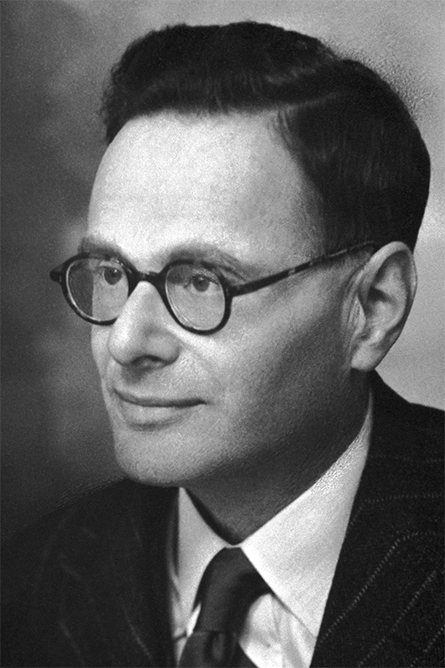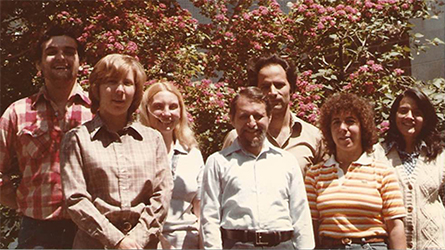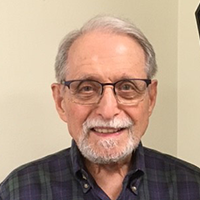Science is a human endeavor
The general public may think of science as a cold, heartless endeavor and of scientists as individuals concerned solely with cold facts, but of course this is not true. Many of us are passionate about our work. We exhibit the same foibles as nonscientists: hubris, jealousy, competition, exhilaration, disappointment. Much of what we do depends on human interactions, and our work is affected by the lives and deaths of our colleagues and peers.

in the study of cellular respiration and discovered the citric acid and urea cycles.
One of the most frustrating periods of my research career occurred in the early 1980s. While reviewing scientific literature in the late 1970s for a review I was writing about the enzyme glucose 6-phosphate dehydrogenase, or G6PD, for the series Advances in Enzymology, I ran across a paper published in 1974 by Leonard Eggleston and Hans Krebs that aroused my interest. It purported to describe a novel mechanism for the regulation of hepatic G6PD by an unidentified factor.
In March 1977, I wrote to Krebs asking whether any further unpublished work had been done that I could cite in my review. He replied that since Eggleston had died the work had been in abeyance but that he recently had taken it up again and was trying to identify the factor. He would keep me apprised of any progress. In September, he wrote again that he had nothing new to report; a few attempts to identify the factor had been unsuccessful.
I decided that we would take up this problem in my lab. We did so and encountered baffling difficulties that took long to resolve in a process that included both gratification and grief.
Meeting a giant
Krebs, one of the giants of 20th century biochemistry, was born in Hildesheim, Germany, in 1900. As a Jew, he was forced to resign his position at the University of Freiburg soon after Hitler came to power in 1933. He went to the University of Cambridge in England and then to the University of Sheffield, where he produced his most widely recognized work, the elucidation of the metabolic pathway that became known as the Krebs cycle. In 1953, he was awarded the Nobel Prize in physiology and medicine.
A year later, I was a graduate student at the University of Chicago when Krebs came to spend a month in the biochemistry department. We graduate students had a biochemistry club, and that year I was its president (the title was actually “dictator”). We invited him to give a talk, which he did. This is how I first met him. I met him several times subsequently and was always impressed that he remembered me and details about me.
When I was on sabbatical leave at Oxford University in 1973-1974, Krebs had a position at the Radcliff Infirmary, and I talked with him on several occasions. He had led Oxford’s biochemistry department until his mandatory retirement in 1967.
Finding the flaw
I thought — correctly, as it turned out — that the research following up on Krebs’ work would be too risky a problem to give to a graduate student, so I asked my technician, Melody Christoff, to undertake the experiments.
The essence of Krebs’ finding can be summarized as follows: G6PD plays an important role in carbohydrate and lipid metabolism in several tissues including the liver. It catalyzes the oxidation of glucose 6-phosphate using the coenzyme nicotinamide adenine dinucleotide phosphate, or NADP+, which thereby is reduced to NADPH. NADPH is a potent NADP+-competitive inhibitor of G6PD, and in mammalian tissues, it is present in concentrations 100 times greater than that of NADP+. Under these conditions, G6PD should be totally inhibited, yet it is known to be highly active.
Krebs’ experiments sought to resolve this paradox. The Eggleston and Krebs paper reported that rat liver extracts contain an unidentified, macromolecular, highly unstable cofactor, which together with oxidized glutathione overcomes this NADPH inhibition, thus providing a physiological explanation for this paradox. My goal was to identify this cofactor.
First, though, we had to repeat Krebs’ experiments. We devoted enormous time and effort but were unable to confirm certain key findings. I consulted with several colleagues to no avail.
Ultimately, by following minutely every facet of the experimental protocols in the paper, we found two mutually reinforcing errors that had allowed the authors to make their interpretation. The first error was one in basic enzyme kinetics: a large correction they made for the reaction rate in the absence of glucose 6-phosphate that, because of the saturating substrate concentration they used, was unnecessary and thus incorrect. The second error was that their use of ZnCl2 to inhibit endogenous glutathione reductase led to an interfering absorbance at the same wavelength used to measure the enzyme activity. It was critical to inhibit glutathione reductase in their experiments because this enzyme catalyzes the oxidation of NADPH in the presence of oxidized glutathione, thereby removing the inhibitory NADPH; but because of its interfering absorbance, ZnCl2 was an inappropriate choice.
When we took these two artifacts into consideration, we were able to reconcile Krebs and Eggleston’s data with ours but proved that their conclusions were incorrect.
A gracious concession
In September 1980, I wrote a detailed letter to Krebs about our findings and conclusions. I mentioned that I would be in England the following year and would be pleased to meet with him to discuss our data. He replied that he was intensely interested. We met on July 28 for an hour. He was impressed with our work, told me that the problem was important and urged me to publish it but agreed it would be best if we understood it better first. He conceded readily that what they had called a cofactor could well be the result of a constellation of artifacts. Also, I told him that two Spanish workers had repeated his findings using mussel hepatopancreas and that they claimed to have isolated the cofactor.

to give to a graduate student, Richard Levy asked his technician, Melody Christoff,
to undertake the experiments. In this photo of the Levy lab taken in 1981, Christoff
and Levy are third and fourth from the left respectively.
Upon my return to Syracuse, I sent Krebs reprints of a recent article by Birgit Vennesland, who had been my Ph.D. advisor, and one by Efraim Racker, both of which I had mentioned to him at our meeting. I also enclosed two of my recent articles, one on the simultaneous analysis of both activities of dual-nucleotide-specific dehydrogenases and another on its application to the regulation of G6PD from Leuconostoc mesenteroides. I told him I planned to do a little more work on our study and then would write it up for publication and that I would send him a copy. In his reply, dated Aug. 24, 1981, he expressed surprise at Birgit’s lively and robust style of writing, stated that he was somewhat skeptical about the Racker paper and commented favorably about my papers. He also recalled our first meeting in 1954. Two months later, Krebs died unexpectedly.
Meanwhile, Melody and I wound up our research. In February 1983, I submitted the manuscript to the Biochemical Journal, the British journal in which Eggleston and Krebs’ paper had appeared. In my letter to the editor, I provided some background to our work, including the interactions with Krebs, and wrote, “His death so soon after I had seen him and had witnessed his lively and vigorous intellect (seemingly undiminished from 27 years previously, when we had first met) was a great shock and I felt it inappropriate to publish at that time. In the meantime, we have reconfirmed all our findings.”
The journal responded in its editorial report: “The authors appear to have disposed convincingly of a misleading artifact. Their covering letter reveals some anxiety about challenging the work of an eminent scientist so soon after his death, but there can be little doubt that the scientist in question would have wanted to see this matter cleared up and would have been intrigued by the explanation.”
The paper was accepted for publication with minor revisions and appeared that year.
A troubling footnote
When Melody Christoff came to work for me in the early 1980s, she told me she had suffered from leukemia but that it was now in remission. In the fall of 1982, she began to experience signs of a relapse. She was admitted to the Roswell Park Cancer Institute in Buffalo to receive a bone marrow transplant. While she was recovering there in an isolation unit because of her compromised immune system, we continued to correspond about the manuscript.
Early in 1983, Melody wrote that the Roswell Park doctors had found an infection in her. She finished her letter in midsentence, clearly recognizing the import of what she had written. On April 3, she died.
All the bone marrow transplant patients at Roswell Park died because the isolation ward had become contaminated with a fungus; with their drastically compromised immune systems, none of the patients were able to withstand the infection. This resulted, later, in a class-action suit against the institute.
Melody left behind a husband and two daughters. She had been a superb technician and a wonderful human being.
Thus, of the four individuals associated with this study — Eggleston, Krebs, Christoff and Levy — I was now the sole survivor. And just as the Eggleston and Krebs’ paper contained a footnote about Eggleston’s death, so now our paper included a footnote about Melody’s death.
Spectacular fraud
Although not directly pertinent to the work on G6PD described here, the paper by Racker that I sent to Krebs, and about which he expressed skepticism, represents another, darker human dimension in scientific endeavors.
Racker, like Krebs, was one of the leading biochemists of the 20th century. Also like Krebs, he was a Jew who had escaped Nazism, leaving Austria first for Britain and then settling in the United States. (Incidentally, I too am a Jew who escaped Nazi Germany, in my case as a nine-year-old boy.)
The paper I had sent Krebs claimed to provide support for Racker’s hypothesis that ATPase plays a key role in cancer. It had aroused intense discussion in the scientific community, primarily because the lead author, Racker’s graduate student Mark Spector, purportedly had done the experiments so rapidly that it strained credulity. Spector was a brilliant, talented graduate student who appeared to have answers for all the criticisms levelled at him at numerous scientific meetings.
It turned out that the publication was based on completely fabricated data, one of the most spectacular cases of scientific fraud in the second half of the 20th century. Spector’s deception was fabricated cleverly, fooling many, including Racker, whose reputation suffered, but the fraud was exposed. Krebs’ skepticism proved prescient.
Lessons learned
The saga of this work contains several important lessons. First, it bears out the dictum that science is self-correcting. Errors occur even in peer-reviewed, published papers and can be corrected provided they are noticed and pursued.
Second, the pursuit of such errors can be dogged. Melody Christoff and I devoted a great deal of effort to solving this problem because we were convinced that something was wrong and because G6PD regulation was an important subject.
Third, even eminent scientists make mistakes, and one of the great things about the ethos of science is that it cares about the truth, not the reputation of those pursuing it.
Fourth, although science is objective, it is carried out by human beings, and thus subjective factors can impinge. The deaths of Melody Christoff and Hans Krebs will be linked forever with this work in my mind.
Finally, the kindness, graciousness and humility of Hans Krebs, as reflected in all his interactions with me and displayed in the letter mentioned above, left an indelible impression. I have met other distinguished scientists in my life, but few share these attributes with Krebs.
Enjoy reading ASBMB Today?
Become a member to receive the print edition four times a year and the digital edition monthly.
Learn moreGet the latest from ASBMB Today
Enter your email address, and we’ll send you a weekly email with recent articles, interviews and more.
Latest in Opinions
Opinions highlights or most popular articles

The tortoise wins: How slowing down saved my Ph.D.
Graduate student Amy Bounds reflects on how slowing down in the lab not only improved her relationship with work but also made her a more productive scientist.

How pediatric cataracts shaped my scientific journey
Undergraduate student Grace Jones shares how she transformed her childhood cataract diagnosis into a scientific purpose. She explores how biochemistry can bring a clearer vision to others, and how personal history can shape discovery.

Debugging my code and teaching with ChatGPT
AI tools like ChatGPT have changed the way an assistant professor teaches and does research. But, he asserts that real growth still comes from struggle, and educators must help students use AI wisely — as scaffolds, not shortcuts.

AI in the lab: The power of smarter questions
An assistant professor discusses AI's evolution from a buzzword to a trusted research partner. It helps streamline reviews, troubleshoot code, save time and spark ideas, but its success relies on combining AI with expertise and critical thinking.

How AlphaFold transformed my classroom into a research lab
A high school science teacher reflects on how AI-integrated technologies help her students ponder realistic research questions with hands-on learning.

Writing with AI turns chaos into clarity
Associate professor shares how generative AI, used as a creative whiteboard, helps scientists refine ideas, structure complexity and sharpen clarity — transforming the messy process of discovery into compelling science writing.

